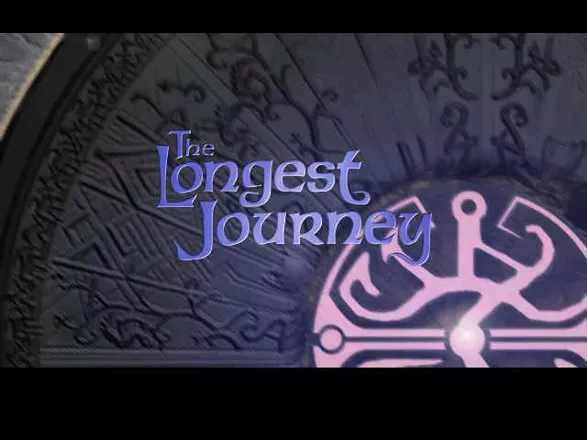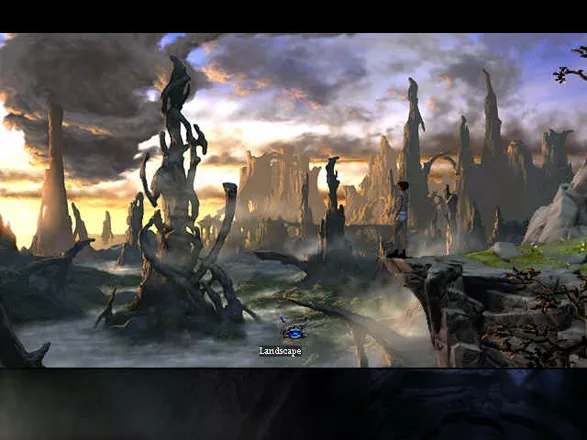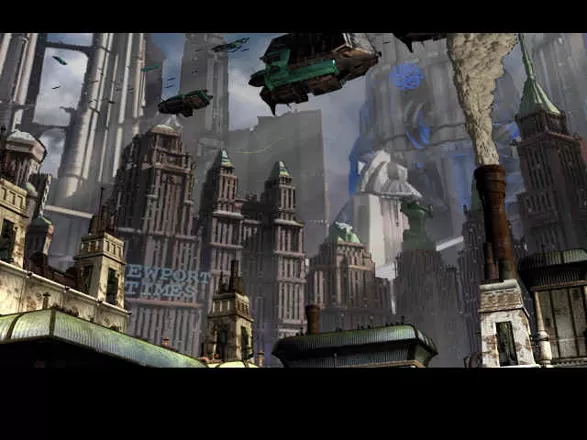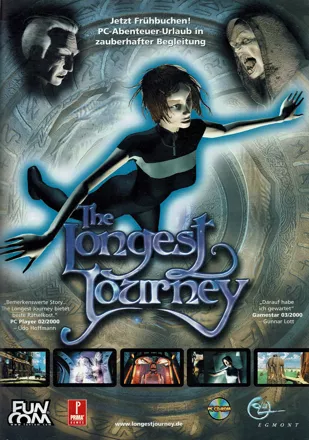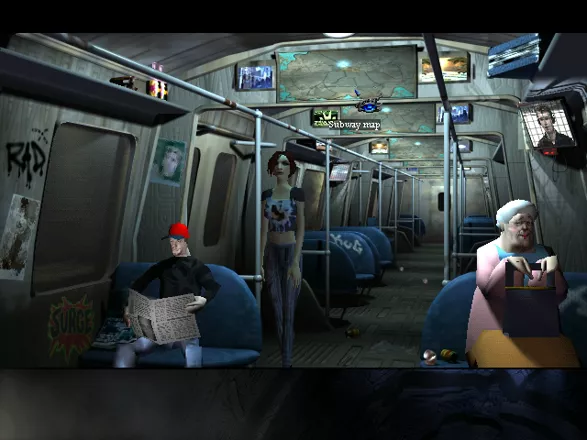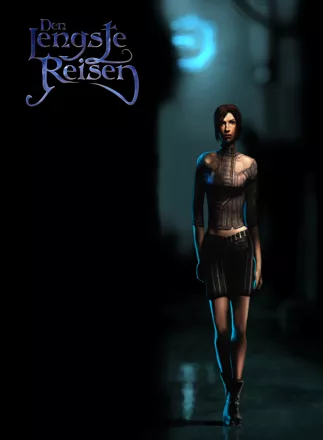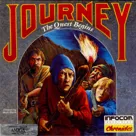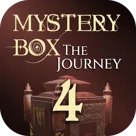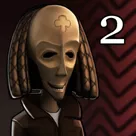The Longest Journey
Description official descriptions
April Ryan is a struggling student artist in the year 2209, recently arrived in the big city of Newport. Lately she has been seeing strange, life-like dreams. Somewhere in the mountains, a mysterious white dragon talks to April, calling her the "mother of the future". When April wakes up, she dismisses the vision as a nightmare. However, an old enigmatic man named Cortez, whom April has spotted near her house before, unexpectedly tells her that she must face the reality in her dreams. Soon April learns that our reality is but one facet of a universe that consists of two parallel worlds: Stark, the world of science and technology, and Arcadia, the world of magic. Though raised in Stark, April possesses the ability of shifting between the two worlds, and must restore the balance in both of them before it is too late.
The Longest Journey is a third-person puzzle-solving adventure game. The player navigates April over pre-rendered backgrounds with fixed camera angles, interacting with people and objects through a simple point-and-click interface. The gameplay follows the traditional template introduced in LucasArts adventures, relying mostly on inventory-based puzzles and multiple-choice dialogues to advance the story. To help keep track of things, the game includes a diary, where April records her thoughts about important events, and a conversation log that records the text of every conversation.
Spellings
- Бесконечное Путешествие - Russian spelling
- 無盡的旅程 - Traditional Chinese spelling
Groups +
Screenshots
Promos
Credits (Windows version)
199 People (193 developers, 6 thanks) · View all
| Producer | |
| Lead Designers | |
| Written By | |
| Art Director | |
| Lead Programmer | |
| Programmers | |
| Installer and Launcher | |
| 3D Studio Max Plug-Ins | |
| Translation Tool | |
| Randy | |
| [ full credits ] | |
Reviews
Critics
Average score: 88% (based on 52 ratings)
Players
Average score: 4.2 out of 5 (based on 212 ratings with 17 reviews)
Stunning. Absolutely brilliant.
The Good
I just finished TLJ, so I'm writing this with a very vivid memory of the game. And the conclusion? The Longest Journey is one of the most beautiful, immersive, spectacular games I've ever played.
The thing that strikes most about TLJ is its unique story; I'll admit I haven't read all that many books in my day, but I've yet to meet a story that's quite as... esoteric as that of TLJ. Somewhat reminiscent of an old favorite of mine, a movie called Flight of Dragons, TLJ manages to beautifully combine a classic fantasy world and a dark, futuristic yet contemporary Earth. The beauty of TLJ is how the writers managed to handle the distinction: Stark and Arcadia, the world of Logic and the world of Magic. The game is absolutely immersive: the open landscape and auspicious landmarks of Arcadia, next to the dark, claustrophobic Stark. Where in Arcadia I felt enthralled and free, in Stark the atmosphere is dark, brooding - as if evil is rampant on every corner... not once did I nearly jump from my seat, not because something surprising happened on the screen, but because the creepy atmosphere made me so nervous a creak or footstep in the house would freak me out.
Add to this the astounding artwork, the variety of settings (futuristic post-industrial world, a fantastic town, underwater city, deserted island and middle-of-center-of-everywhere realm) that are so beautifully thought out and drawn you can almost feel like you're there, spectacular background stories and depth of the game universe, and terrific voice acting to boot - and you've got yourself one of the deepest, most immersive games I've played since Star Control 2.
If that's not enough, this game has what is quite possibly the single best soundtrack ever to be featured in a computer game, written and perfected by Bjorn Arve Lagim. The soundtrack alone is worth the purchase, take my word for it.
The Bad
Unfortunately TLJ is not without its flaws, two serious and one minor. To begin with, the game is plagued with bugs. On my machine (AMD Athlon 1GHz, A7V133 and GeForce2GTS) -- and, to my understanding, on most NVidia-based video cards -- the game crashes whenever I try to enter the police station through the front door. Luckily there's another way of doing this, but that's hardly an excuse. Moreover, the game refuses to run at 32 bits per pixel on my machine, resulting in very dithered animation, thereby detracting from the beautiful graphics. And, to top it off, whenever I switch tasks (using Win2k), the 3D textures and alpha become corrupt and I have to restart the game.
That isn't a big deal, but worse is the fact that at least three or four times throughout the game I got stuck because I failed my pixel-searching (specifically, I didn't locate the valve on the machine next to the Boarding House, the light switch in the police station toilettes and another something I can't remember offhand). Also, being a linear game (which, so long as not blatantly obvious a la Max Payne, is not necessarily a bad thing) it happened once or twice that I didn't realize I had to do something before another event occured (for example [spoiler alert]: giving the map to Flipper before the pizza appears in the trashcan). That is the only reason I had to use a walkthrough, and I hate using walkthroughs.
The third problem is the fact that towards the end of the game (starting from the sixth episode or so where it's not as apparent, becoming a much bigger issue towards the tenth episode) some puzzles get much, much easier; for example, killing the snapjaw and finding the talisman isn't even a puzzle; neither is getting rid of the Chaos Vortex and helping Adrian fend off Gordon. The fact that monsters like The Gribbler and the mutant at the end don't even give you a run for your money is both good and bad: good because it means you can't die and won't have to reload, bad because it emphasizes the linearity of the game (or rather shouts it out loud).
Finally I'd just like to say that while the above detracts from the game, it by no means makes it unplayable -- just be prepared for an occasional grunting.
The Bottom Line
An incredible game with a deep storyline, great graphics and incredible music. Recommended for anyone who loves adventures.
Windows · by Tomer Gabel (4538) · 2001
Spread your legs!... AND DO THE MONKEYYYYY!!
The Good
(In order to illustrate critical points, this review contains some spoilers for portions of The Longest Journey. You have been warned.)
The Longest Journey is an innovative approach to a genre that desperately needs a breath of fresh air. It's a story about storytelling itself, and more specifically about the very genre of adventure, with a clever device (April's diary) that allows the game to get away with using most of the old adventure cliches (saving the world, collecting a set of jewels, always running errands for everyone), while simultaneously poking good-natured fun at them.
From an audiovisual standpoint, TLJ is a beautiful piece of software. The story is rich, detailed, and LONG, with many conversations spanning as much twenty or thirty minutes. Opinions on this vary, and it will definitely bore players who hate conversation-driven games (not to mention looking at the same screen for any length of time), but I personally felt the extra time and attention to detail in April's world, and the people she knows, created emotional involvement that paid off big-time in the game's second half. The fantasy landscapes are gorgeous to look at, and give something to take in as you're listening to the characters talking. Also, all the conversation delivers a long play time, without forcing players to spend it all solving puzzles and constantly getting stuck.
As an adventure protagonist, April shines. She's extremely easy to like, funny and friendly, and pleasant to listen to (a absolute must since she carries the bulk of the game's dialogue). Not to mention she's a lot more... how I say?... realistically proportioned than, for instance, Lara Croft.
The game is easy to get running, even on older machines. There are no big system-limitation problems, no 64MB AGP accelerators required, and you have the ability to turn off the fancier features and still be able to enjoy the game. (I definitely recommend doing the full 1GB install, though, if you can afford the space.)
The Bad
(LAST CHANCE to avoid the spoilers!)
The rest of the voice acting is good overall, never stiff, but sometimes the game's situations give the canned responses an awkward feel. For instance, when Emily gets shot and April escapes the clutches of the Vanguard, she doesn't know whether her best friend is dead or alive. It should be a very emotional moment, but have April examine her clothes at this point and she points out how, "ARRRRRR, matey!" she looks like a real sailor. Also you still get the "identical voice" effect from having a small cast playing a large number of characters, to the extent that some of them sound very much alike. (Toward the end, with each new character that was introduced, I was able to easily identify the other voices played by the same actor.)
Some of the puzzles and situations are thoroughly contrived, and this doesn't mesh well at all with a story that tries so hard to be original and serious. Take the police station in Stark, for instance: April manages to get into a restricted area because the electronic doors JUST HAPPEN to be broken that day. Then she's able to bypass the retinal scanner because one of the cops on the force JUST HAPPENS to have an artificial eye. Then she's able to get his password because she finds out it's based on his wife's birthday, and she's able to bring up the subject because it JUST HAPPENS to be the very next day. Yrrrrghhh...
The interface itself is occasionally inconsistent. Sometimes you get all the info you need when you examine something the first time, and sometimes it takes you two looks before you see what's really important. To give an item to a character, sometimes you click the item then click it on them, and sometimes you have to talk to the character and choose the line of dialogue that indicates you have the item. In the case of Crow, you click on HIM, then click him on the object you want to use him with. It wouldn't have been so hard to implement multiple methods of achieving the same end. There are also a couple of Myst-ish puzzles, Ancient Mysterious Objects (TM) that must be manipulated in the right way to accomplish something. I've never enjoyed this sort of puzzle, personally.
Inevitably, as with all adventure games, there are points where you run out of options, get stuck, and resort to the "click everything on everything else" method to find the one thing that works that you somehow missed. And this means not understanding the solution until after you've arrived at it. Case in point: I tied the clothesline to the clamp and attached the inflatable duck with no idea why I was doing it, except that the game was letting me. It's only after I noticed the key in the subway that I suddenly had a use for the previously purposeless contraption I'd constructed.
Worst of all, TLJ still suffers from the adventure gaming "broken record": You can talk to characters as many times as you want, and if you've exhausted all conversational possibilities you'll still continue to get the same "Hi"-"Bye" exchange. If you don't get a timing-related puzzle right on the first try, the game makes the event occur over and over until you do. The biggest offenses here are in the case of Officer Minelli dropping and picking up his synthetic eye before you can grab it, and, even worse, "escaping" the Gribbler in the forest. The Gribbler "attacks" April initially, but never chases her beyond that. She can hide behind the table as long as you let her, and the Gribbler never tries to run around and grab her. Once you realize this, any hope of tension is POOF, gone, and the game's urgent music becomes ludicrous. (On the other hand, I do realize that "dying" in an adventure is politically incorrect these days, that people hate "save-and-restore" puzzles. I have yet to see a game that walks this thin line successfully.)
And, once you're completely finished, the game doesn't have much replay value. While the lengthy dialogues weren't hard to sit and listen for me, I currently have no desire to back through any of it, and probably won't for a very long time.
The Bottom Line
Hmm, reading back through the above, it seems to give the impression that I didn't like The Longest Journey. On the contrary, I found it stylish, compelling, and a definite must-play for any adventure fan, though still flawed. Though its story is a solid piece of fiction, I felt it was lacking a few things that would have made a truly great GAME. While certainly the best commercial adventure game in recent years (since Grim Fandango), The Longest Journey still doesn't do much game-wise that's truly innovative, or to revive the fading genre of pure adventure as a whole. But it should give adventure holdouts faith to keep waiting for the next great game (possibly the just-announced sequel), and maybe that one will succeed.
Windows · by Ye Olde Infocomme Shoppe (1674) · 2002
The Good
The biggest boon of The Longest Journey is its world and lore. The story is about two parallel worlds - Stark, the world of science, and Arcadia, the world of chaos - which in itself is not the most original story idea. However, Ragnar Tørnquist obviously spent a lot of time working out every little detail, which makes even the most long-winded exposition dump a delight to hear. I especially like Arcadia, which manages to avoid most usual Tolkien/D&D tropes and offers original races and aspects.
The dialogue writing is only serviceable - they are way too wordy and exposition-heavy - but the characters are still interesting and likeable (at least the ones which are supposed to be). The plot itself is also not especially innovative if you cut out the fluff, but thanks to the lore and characters it always stays fascinating until the surprisingly heart-warming ending. The protagonist April Ryan is not very interesting, but fortunately her excellent voice actor saves the day.
The Bad
The title The Longest Journey is well-chosen: even for 2000 standards, this is a very long adventure game. Unfortunately for all the wrong reasons. There are various endless long animations which have to be endured over and over again. For example, at one time the player needs to read multiple lore books in a library and the librarian takes almost a full minute to retrieve a book from the shelf. Many people speak very slowly and overemphasize every single sentence because they are supposed to be profound.
The game is full of useless screens which are only present to watch April walk through them frequently. Very slowly of course - and this refers to her running speed. This makes the game a chore to play, even when using the escape key to skip many animations (which has to be enabled in the game options and can skip important sequences if not used carefully).
I usually don't talk about graphics in my reviews, but boy is this game ugly. The backgrounds are pretty, but the characters look like they were directly taken from a grotesque horror movie. Especially the rendered cutscenes are bad, with questionable animations and horrible faces - April looks more like The Nameless One than a teenage girl.
The puzzle design is atrocious. I don't think I need to repeat the famous tale of the rubber duck which proudly even beats the cat mustache in infamy. However, this is only the most prominent example; the whole game is full of stupid puzzles. They make no sense, they don't fit the world and their only purpose is to slow down the game even more.
The Bottom Line
I loved The Longest Journey back in the day, I really did. I started my replay with the expectation to write a glowing review for one of my favorite adventures of all times. It is a shame it is held down by bad gameplay and its slowness, because the world, the lore and the characters are among the most interesting in adventure game history. Unfortunately I believe this is a game which is only digestible for people who enjoyed it close to its original release and those should probably not ruin their good memories by playing it again.
Windows · by Patrick Bregger (299645) · 2021
Discussion
| Subject | By | Date |
|---|---|---|
| remake? | hvrsd hvrsd (1) | Jul 11, 2007 |
Trivia
1001 Video Games
The Longest Journey appears in the book 1001 Video Games You Must Play Before You Die by General Editor Tony Mott.
April Ryan
The publisher of The Longest Journey, Egmont Interactive, actually tried to turn April Ryan into a pop icon to match Lara Croft. To that end, they cast a real-life model for April -- 23 years old psychology student Katja Koopmann of Bremen, Germany -- and toured the major magazine and newspaper offices with her, dressed up like April and sputtering lines like “I find April sympathetic” with a somewhat forced smile. Once the PR machine runs, even mediocre game sales can’t stop it. On her way to media star, the virtual April next recorded a song -- a dance remix of the 80’s Depeche Mode tune The Balance -- and Katja lend her voice. Egmont spiced April’s image up with exceptionally stupid PR blurb like “I want everything! Above all, I want to show the people of your world something of the life here!” Generally ignored by the public, the song entered the stores on April 14th ‘00, and stayed there. The corresponding video clip was never played on the music channels, the song didn’t appear in the radio shows, and nobody bought the CD.
Dreamweb
The main character's name is April Ryan, just like Ryan in the game Dreamweb, also published by Empire Interactive Entertainment. And the plots of both games have some things in common (the hero who suffers from nightmares and must save a world he/she didn't even know existed in the first place).
References
- A reference to the Monkey Island series: April's pet toy is called Constable Guybrush. And yes, it's a monkey.
- There are lots of references to sci-fi movies and fantasy themes. Most prominent are the references to Brazil, for instance, which takes place on a red tape-clogged insensitive world much like stark. Take a look at the lobby of the Church of Voltec, it's an exact replica of the Information Retrieval building on Brazil. Also the whole repairmen puzzle where they refuse to work on the grounds that it would require a specific form for them to do so is a spoof of the "Central Services" sequence in the movie. They are even dressed in the same way! There are many more, some more subtle than others.
- Want Star Wars references? check out that strange metal ball on the entrance to The Fringe Café. It says "Death Star" click on it and April will spout famous lines related to it, like "Let's blow this thing and go home!" and she even tries to imitate the voices!
Sales
The Longest Journey was originally made only to be released in Scandinavia, but it then grew with the sales to cover Europe and the U.S. By June of 2001, The Longest Journey had sold 250,000 copies worldwide, 90,000 of which were in America.
Version differences
In order to preserve his foreigner condition, Cortez had his nationality changed from Spanish to French and was renamed "Corthez" in the Spanish version.
Voice acting
- The character Marcus, who only appears in the first chapter near the Fringe cafè, and only has two lines, was voiced by Ragnar Tørnquist, the director/lead designer of the game for the English release.
- In the German pre-release demo version, April was voiced by German pop singer T-Seven known from the, at the time, successful Eurodance group Mr. President. In the final game, April was voiced by Stephanie Kindermann.
Awards
- Computer Gaming World
- April 2000 (Issue #201) - Adventure Game of the Year
- Gamespy
- 2000 - Adventure Game of the Year
- PC Gamer
- 2000 - Adventure Game of the Year
Information also contributed by -Chris, Agent 5, jeremy strope, Karthik KANE, kelmer, Stargazer and Zovni
Analytics
Upgrade to MobyPro to view research rankings!
Related Sites +
-
Hints for The Longest Journey
Adventurers will appreciate these hints. They let you solve the game yourself without spoiling it for you. -
Interview with Ragnar Tornquist
Randy Sluganski talks with Mr. Tornquist about The Longest Journey and its upcoming sequel. -
TLJwiki
A wiki covering the The Longest Journey series. -
The Divide .org - Powered by The Longest Journey Fans
Fansite dedicated to The Longest Journey, an awesome PC adventure game produced by Funcom. Features fan fictions, fan arts, wallpapers, downloads, news, polls, and discussion board. -
Zarf's Review
A review of The Longest Journey by Andrew Plotkin (December, 2002).
Identifiers +
Contribute
Are you familiar with this game? Help document and preserve this entry in video game history! If your contribution is approved, you will earn points and be credited as a contributor.
Contributors to this Entry
Game added by andyhat.
iPad, iPhone added by MrMamen.
Additional contributors: n-n, Robin Lionheart, curacao, Jeanne, JRK, Dec Ryan, Kabushi, Stratege, Zeppin, Laverne, Paulus18950, Patrick Bregger, MrMamen, FatherJack.
Game added May 14, 2000. Last modified March 12, 2024.




